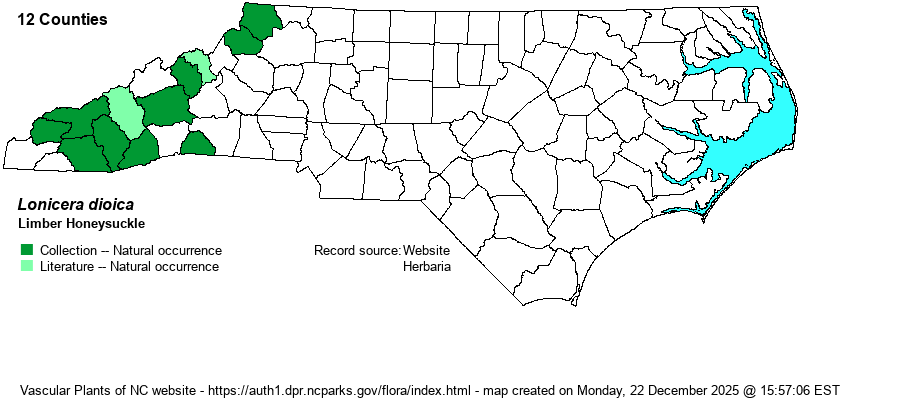| Author | L. | |
| Distribution | Mostly in the Mountains, occurring nearly throughout, but with some counties lacking records. Also Polk County in upper Piedmont.
This species has a rather broad range to the north and west of the state. It occurs across most of southern Canada south to PA, northern GA, and OK. It avoids the Piedmont province south of PA.
| |
| Abundance | Rare to very uncommon. Slightly less rare than is L. canadensis. It was considered by the NC NHP as a Watch List species until fairly recently, but it has no conservation status now. As a result, the editors suggest that the State Rank is better at S2S3 instead of the current S2. | |
| Habitat | This species tends to favor somewhat damp and rich soils at middle and high elevations. It occurs in bogs, seepages, moist woods, and upland forests or glades over mafic rock. |
| Phenology | Blooms from June to August, and fruits from August to September. | |
| Identification | This is a woody vine that twines over shrubs and other vegetation to a length up to 8-12 feet long. It has opposite deciduous leaves that are widely ovate, entire on the margins, sessile, and rounded at the tip, and grow to about 2-2.5 inches long. The last pair of leaves, at the branch tip, are fused into a cup or disk, which “house” a cluster of showy yellow to red flowers. The fruits are red berries, in a cluster, at the tips of branches. To most field biologists, the species is similar to the much more familiar Coral Honeysuckle (L. sempervirens), but that species does not grow in cool and damp sites in the higher mountains, nor does it have yellow to reddish, wide-spreading flowers. Japanese honeysuckle (L. japonica) does not have the branch tips terminated by a fused cup of two leaves, and its flowers and fruits grow in leaf axils; it also has white/cream flowers and black berries. Yellow Honeysuckle (L. flava) is quite similar but it has gray undersides to the leaves as opposed to whitish in L. dioica, has bright orange to orange-yellow flowers, and grows around granitic domes. | |
| Taxonomic Comments | Some authorities list varieties for this species, as does NatureServe. Weakley (2024), however, does not list varieties for it.
| |
| Other Common Name(s) | Wild Honeysuckle (too vague), Glaucous Honeysuckle, Red Honeysuckle, Twining Honeysuckle, Smooth Honeysuckle | |
| State Rank | S2 [S2S3] | |
| Global Rank | G5 | |
| State Status | | |
| US Status | | |
| USACE-agcp | FACU link |
| USACE-emp | FACU link |

